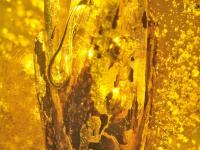Flood Basalt Eruptions

A flood basalt is the result of a giant volcanic eruption or series of eruptions that coats large stretches of land or the ocean floor with basalt lava. Flood basalt provinces such as the Deccan Traps of India are often called traps, which derives from the characteristic stairstep geomorphology of many associated landscapes. Rampino and Stothers (1988) cite eleven distinct flood basalt episodes occurring in the past 250 million years, creating large volcanic provinces, plateaus, and mountain ranges. However, more have been recognized such as the large Ontong Java Plateau, and the Chilcotin Group, though the latter may be linked to the Columbia River Basalt Group. Large igneous provinces have been connected to five mass extinction events, and may be associated with bolide impacts.
Formation

The formation and effects of a flood basalt depend on a range of factors, such as continental configuration, latitude, volume, rate, duration of eruption, style and setting (continental vs. oceanic), the preexisting climate state, and the biota resilience to change.
One proposed explanation for flood basalts is that they are caused by the combination of continental rifting and its associated decompression melting, in conjunction with a mantle plume also undergoing decompression melting, producing vast quantities of a tholeiitic basaltic magma. These have a very low viscosity, which is why they ‘flood’ rather than form taller volcanoes. Another explanation is that they result from the release, over a short time period, of melt that has accumulated in the mantle over a long time period.
The Deccan Traps of central India, the Siberian Traps, and the Columbia River Plateau of western North America are three regions covered by prehistoric flood basalts. The Mesoproterozoic Mackenzie Large Igneous Province in Canada contains the Coppermine River flood basalts related to the Muskox layered intrusion. The maria on the Moon are additional, even more extensive, flood basalts. Flood basalts on the ocean floor produce oceanic plateaus.
The surface covered by one eruption can vary from around 200,000 km² (Karoo) to 1,500,000 km² (Siberian Traps). The thickness can vary from 2000 metres (Deccan Traps) to 12,000 m (Lake Superior). These are smaller than the original volumes due to erosion.
Petrography
Flood basalts have tholeiite and olivine compositions (according to the classification of Yoder and Tilley). The composition of the basalts from the Paraná is fairly typical of that of flood basalts; it contains phenocrysts occupying around 25% of the volume of rock in a fine-grained matrix. These phenocrysts are pyroxenes (augite and pigeonite), plagioclases, opaque crystals such as titanium rich magnetite or ilmenite, and occasionally some olivine. Sometimes more differentiated volcanic products such as andesites, dacites and rhyodacites have been observed, but only in small quantities at the top of former magma chambers.

Structures
Subaerial flood basalts can be of two kinds:
- with a smooth or twisted surface: very compact surface; vesicles (gas bubbles) are rare. Degassing was easy (magma maintained at a high temperature and more fluid in a chamber of a size such that confining pressures did not confine gases to the melt before expulsion). Such lava flows may form underground rivers; when degassing fractures and conduits are present, very large flows may reach the surface.
- with a chaotic surface : the basalt flood is very rich in bubbles of gas, with an irregular, fragmental surface. Degassing was difficult (less fluid magma expelled from a rift with no chance of progressive expansion in a hot chamber; the degassing took place closer to the surface where the flow forms a crust which cracks under the pressure of the gases in the flow itself and during more rapid cooling).
In the Massif Central in Auvergne, France, there is a good example of chaotic lava flow, produced by eruptions from Puy de la Vache and Puy de Lassolas.
Geochemistry
Geochemical analysis of the major oxides reveals a composition close to that of mid-ocean ridge basalts (MORB) but also close to that of ocean island basalts (OIB). These are in fact tholeiites with a silicon dioxide percentage close to 50%.
Two kinds of basaltic flood basalts can be distinguished:
- those poor in P2O5 and in TiO2, called low phosphorus and titanium
- those rich in P2O5 and in TiO2, called high phosphorus and titanium
The isotopic ratios 87Sr/86Sr and 206Pb/204Pb are different from that observed in general, which shows that the basalt flood magma was contaminated as it passed through the continental crust. It is this contamination that explains the difference between the two kinds of basalt mentioned above. The low phosphorus and titanium type has an excess of elements from the crust such as potassium and strontium.
The content in incompatible elements of flood basalts is lower than that of ocean island basalts, but higher than that of mid-ocean ridge basalts.
Other occurrences
Basalt floods on the planet Venus are larger than those on Earth.
Source: BBC Earth








